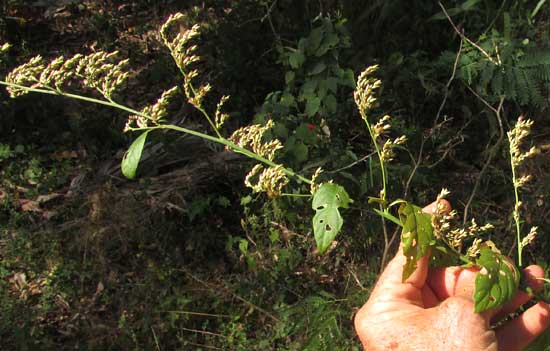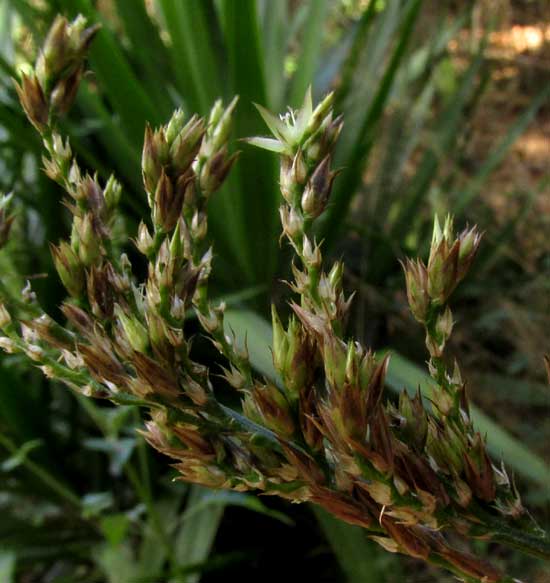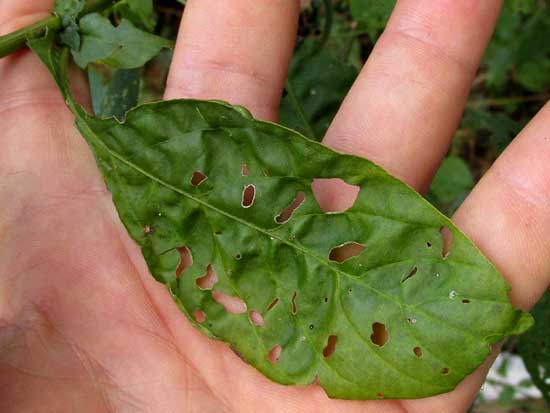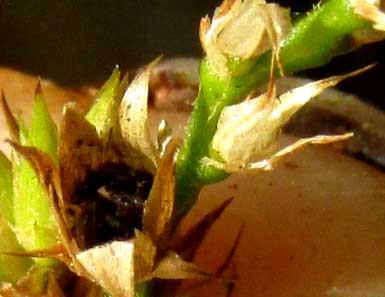Excerpts from Jim Conrad's
Naturalist Newsletter
from the February 25, 2018 Newsletter issued from Rancho Regenesis in the woods ±4kms west of Ek Balam Ruins; elevation ~40m (~130 ft), N20.876°, W88.170°; north-central Yucatán, MÉXICO
A RANGY CELOSIA
Below, take a look at a stem of the 7-ft-tall (2m) herb extracted from a dense tangle of weeds next to the rancho's chicken pen:

The slender clusters at the sprig's outermost points are flowering spikes, as you can see in a close-up below:

In that picture, note the open flower at the tip of the middle spike. A flower closeup is shown below:

In the Amaranth Family flower petals are lacking, so the green, sharply pointed items looking like green petals are "tepals," tepal being the term used when in a flower there's no distinction between a calyx and corolla. Otherwise, the blossom's stigma, style, ovary and stamens all look fairly normal, except for the stamens' filament bases merging to form a shallow bowl at the spherical ovary's bottom. That's a good field mark.
And good field marks are needed, because several species in different genera of the Amaranth Family at first glance can be confused with this species. For example, our plant looks a good bit like large, tropical specimens in the genus Iresine diffusa. However, in the genus Iresine leaves arise opposite one another on the stems, not alternate as on our plant. A bug-eaten leaf of our plant is shown below:

Our plant also could be easily mistaken as a large, tropical example of the Smooth Amaranth, or Smooth Pigweed, Amaranthus hybridus. However, the tiny, bladder-like fruits -- known as "utricles" -- produced by amaranth species, genus Amaranthus, contain just one seed per utricle, while if you look closely at split-open fruits of our chicken-pen plant, it looks like several black seeds can be seen inside, as you might be able to see below:

Actually, the best way to determine how may seeds one of these plant's fruits contain is to pick a single fruit, crush it between your thumb and finger, and see how many tiny black seeds pop out. When I did that with our plant, I got three to five, so our plant isn't an amaranth.
Leaves one per stem node (alternate), and more than one seed per utricle... In our area that brings you to the genus Celosia. Usually when we think of Celosia we visualize colorful cockscomb garden plants such as the variously colored ones on our Plumed Cockscomb page at www.backyardnature.net/n/h/celosia.htm
However, Celosia embraces about 65 mostly tropical species, and some of them are gangling weeds like our chicken-pen one. Our plant is CELOSIA VIRGATA, apparently with no good English name, but just calling it Celosia is good enough. It's distributed here and there in Mexico and the Caribbean south through Central America into northern South America. Pictures on the Internet usually show smaller, more compact plants, so apparently ours is an exceptionally robust one, which might be explained by its having all that good chicken manure nearby, fertilizing it.